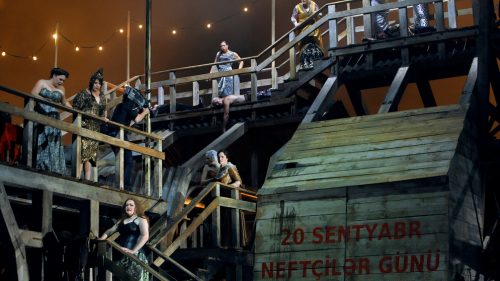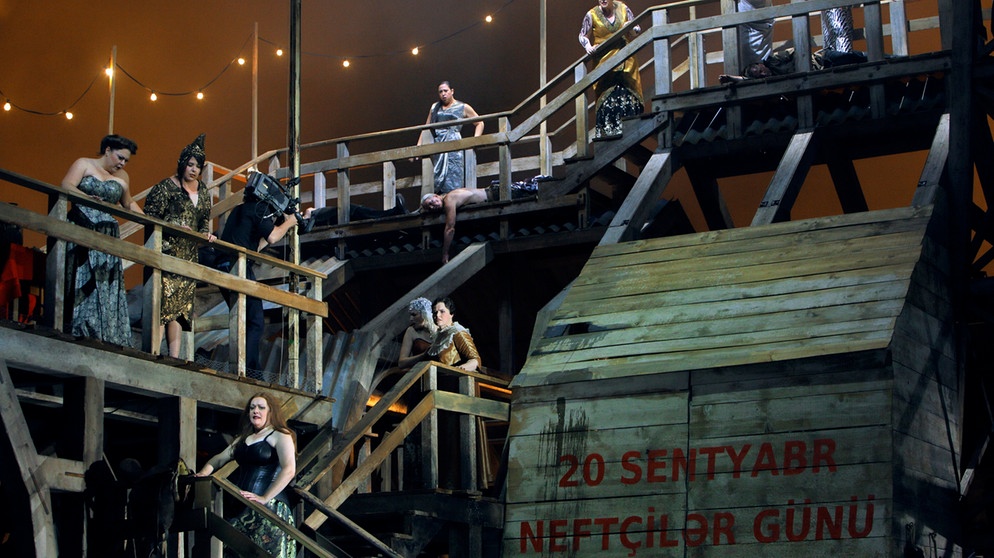 Germany Wagner, Die Walküre: Soloists, Bayreuth Festival Orchestra / Marek Janowski (conductor). 2016 performance from the Bayreuth Festspielhaus and reviewed when streamed on DG Stage. (CC)
Germany Wagner, Die Walküre: Soloists, Bayreuth Festival Orchestra / Marek Janowski (conductor). 2016 performance from the Bayreuth Festspielhaus and reviewed when streamed on DG Stage. (CC)

Production:
Stage Director – Frank Castorf
Stage Design – Aleksandar Denić
Costumes – Aldiana Braga Peterzki
Lighting – Rainer Casper
Video – Andreas Deinert, Jens Crull
Cast:
Siegmund – Christopher Ventris
Hunding – Georg Zeppenfeld
Wotan – John Lundgren
Sieglinde – Heidi Melton
Brünnhilde – Catherine Foster
Fricka – Sarah Connolly
Gerhilde – Caroline Wenbourne
Ortlinde – Dara Hobbs
Waltraute – Stephanie Houtzeel
Schwertleite – Nadine Weissmann
Helmwige – Christiane Kohl
Siegrune – Mareike Morr
Grimgerde – Weibke Lehmkuhl
Rossweise – Alexandra Petersamer –
Prefaced by the same talk from Marek Janowski as that which started the Das Rheingold experience, the Frank Castorf Ring cycle now moves to Baku, Azerbaijan (known for its oil, coveted by the Nazis in World War II). This time, in the stormy Prelude to Act I, we see Janowski conduct, though, semi-casual in striped blue shirt, no tie, vigorous of movement, thoroughly committed.
Although named as placed in Azerbaijan, initially we could be almost anywhere. There is a wooden hut, strung bare light bulbs. A live bird is held in a cage; haystacks are strewn around the stage. The Sieglinde, Heidi Melton, is excellent at the lower dynamic levels, powerful when required; she has the lower notes for ‘Der Männe Sippe’, too. Christopher Ventris’s Wagnerian credentials are huge (he is best known for the title role in Parsifal) and he excels here. He comes into his own with the cries of ‘Wälse’ and giving a beautiful ‘Nächtiges Dunkel’. There is some strain on his voice at times (he cracks just before ‘Winterstürme’), but he still has the reserves for the big moments.
Hunding enters with a bloody human head on a stick, while on his own head he sports a top hat. Once again, as in Das Rheingold, the stage has multiple levels so that Sieglinde can see Siegmund and Hunding from above as she prepares the table for Hunding’s meal. Georg Zeppenfeld is a tremendous bass, young-looking up close but made to look older (and more forbidding) at a distance. His threatening demeanour (he starts every time Sieglinde asks a question, moving closer to her as if to silence her) is most effective, and vocally he is authoritative. Power over others, animal or human, defines him – he puts two spotlights on Siegmund, as if to interrogate the interloper.
Once again, film comes into the equation: we see Sieglinde in black and white projection as she prepares the sleeping drought; in return, Hunding watches her with the look of a 1920s horror movie villain; there is more than a touch of Nosferatu here. Later, we see Hunding in a fitful sleep as the incestuous love awakens elsewhere in the dwelling. But the onus seems to have shifted somewhat, from the intrusions of privacy in Das Rheingold to something more dramatically intense: when the Valkyries are set into a frenzy in the earlier parts of Act III around Wotan and Brünnhilde’s relationship, the use of close-up black and white brings home the turmoil here. When it comes to Nothung, we initially have an image of a sword that seems to look, from some angles, like a mandrake root, which seems to take the phallic symbolism of swords a step further (shades of John Donne, perhaps). And, unsurprisingly by now, Sieglinde gives Nothung a very suggestive stroke that anchors phallic parallels in the viewers’ minds forever; and there is surely no doubt that at the very close of the act, with Siegmund holding the sword aloft, rigid and erect, this is no mere accident.
Although I might have wanted more of a long-term view from Janowski in this first act, his awareness of detail is remarkable, and he creates pure tension in Siegmund’s ‘Ein trauriges Kind’ section. Act II offers greater challenges for the conductor. A wooden watchtower forms the backdrop; we have a remarkably human Wotan, not above sitting reading the paper (Pravda, what else?) and sipping liquor. John Lundgren, bald with long white beard, is a good Wotan; anywhere else he might be labelled superb, especially around ‘Götternot’, but Sarah Connolly is in the house. This Fricka might be dressed like a gypsy fortune teller who just happens to carry a whip; but we certainly know who wears the trousers here, vocally, too. This act is one of the greatest interpretative challenges in the Ring, a real turning point in direction and an opportunity to forensically see into Wotan’s psyche. It should put us through the wringer. If Janowski just falls short of that, we still remain moved.
In this performance, this is the ladies’ act, Catherine Foster having an absolute ball with her ‘Hojotoho! Hojotoho! Heiaha!’, yet later finding real tenderness in her later replies to Siegmund’s heart-breaking questions. Here, this becomes the focus, the most memorable moment. The Siegmund/Brünnhilde scenes are propelled forward by Janowski as if on wings (to some loss of lyricism).
The huge, multi-levelled wooden lookout-tower/edifice forms a playground for the Valkyries at the start of the third act, a superb bunch (one would expect no weak link at Bayreuth, and so it is); perhaps a special word for the young and incredibly powerful Helmwige of Christiane Kohl. Dizzying juxtapositions of the cameras’ black and white and the stage colour add to the feeling of unconstrained energy. One does wonder if the illuminated pentagram later in the act is a reference to the Nazi fascination with occultism …
If anything, I found Heidi Melton’s Sieglinde more convincing in the final act, a glowing ‘O hehrstes Wunder!’ crowning her evening. Catherine Foster’s Brünnhilde, too, was a thing of wonder, as if growing through the performance towards that greatest of father-daughter farewells, her vulnerability palpable at ‘Hier bin ich, Vater’. It is Foster who really shines in the work’s final stretches (which includes, as one might by now have predicted, a good old father-daughter snog, although the very final parting finds them touching foreheads). The ring of fire is actually an oil drum on fire, and Brünnhilde just goes to bed, where she will presumably stay until the arrival of the fearless hero, Siegfried.
Die Walküre, even on film(s), should leave one shattered; when I attended the a Gothenburg performance in December last year conducted by Evan Rogister with the amazing Elisabet Strid as the stand-out cast member (Sieglinde), certainly that was the case (there is a Seen and Heard International review by Niklas Smith here). For all its qualities, Janowski’s Walküre left me impressed but not wiped out except for the elation of going through an entire Walküre sans interval (you pick your own intervals – or not, for the more masochistic amongst us – by pausing the stream at the relevant point).
But the opportunity to see and hear Sarah Connolly’s Fricka and Christopher Ventris’s Siegmund should not be missed, well worth a stream, and a bargain at the price.
Colin Clarke
For what is on DG Stage click here.
